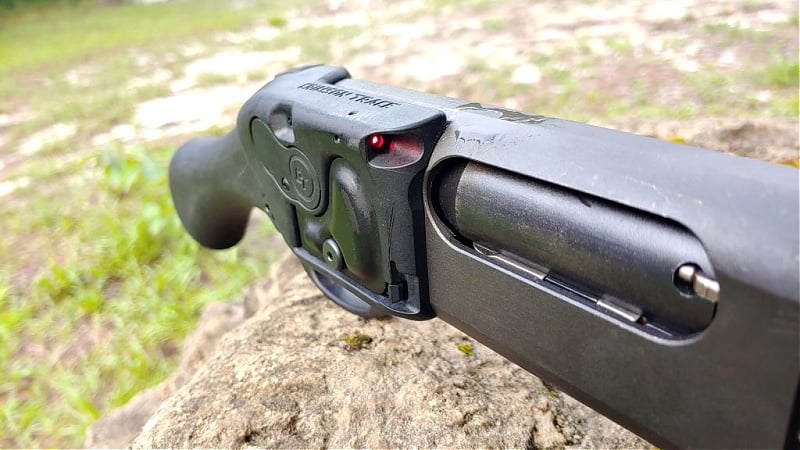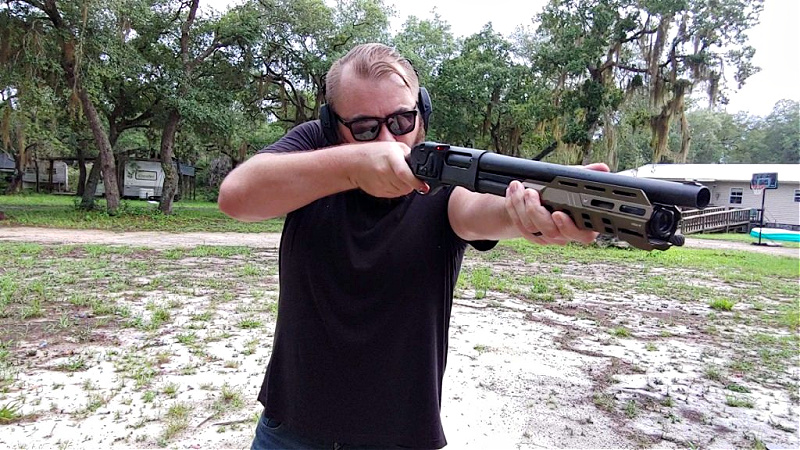I’ve stopped trying to justify use cases for specific firearm and accessory purchases. Why would I? It’s in the Bill of Rights, and I don’t have to explain anything to anyone. Most of my guns were purchased because they are fun guns. One of the most fun series of firearms is the 12 gauge ‘firearms’ that have become popular in the last few years. The TAC 14 and Shockwave are a blast, and the only thing that makes them even more fun is the Crimson Trace Laser Saddle.

There is certainly a debate on the usefulness of visible lasers in defensive firearm shooting, and I don’t want to dive into that today. However, on a stockless 12 gauge ‘firearm,’ the idea of a laser isn’t quite so silly, especially when it comes to having a little fun. The Crimson Trace Laser Saddle is designed for either the Mossberg 500/590 or the Remington TAC-14.
Both are pump-action weapons, and attaching accessories to these weapons usually involves the pump. The problem with connecting a laser to a pump is that the pump moves. They wiggle and jiggle and don’t always index in the same area. Lasers are aiming devices and must mount to a stable platform, which the pump is most certainly not. Crimson Trace figured out how to add a laser to a pump-action shotgun without needing the pump.
Installing the Laser Saddle
Attaching the Laser Saddle to your firearm of choice is super easy. It mounts to the right side of your receiver and uses the same bolts that hold your trigger guard in the gun. It attaches tight and remains stable. Installation took about two minutes total. The Laser Saddle installs a little differently on the Remington than the Mossberg, but it’s still fairly similar.

With the Mossberg model, you can still easily mount optics and rails. They say you can still use a side saddle, but it better be one of those Velcro elastic card designs because the bolts most commonly used to hold side saddles are taken up by the Laser Saddle.
The ergonomics and controls vary between guns, with the Shockwave having a button on the side of the saddle that’s huge and easy to press. On the Remington model, the button is positioned at the top, similar to Mossberg’s safety position. It adds barely any bulk or weight and is a simple addition to the gun.

Zeroing is easy, and you turn some knobs until you hit where you want to. I lined it up with the TAC-14’s bead sight and let it rip. That seemed to be good enough for hitting clay pigeons on a berm.
Defensive Use of the Laser Saddle?
Pistol grip-only firearms are a ton of fun, and they due have limited niche defensive use for close-quarters fighting. It’s not for everyone and takes a fair bit of training to use effectively. In that niche, the Laser Saddle can be a valuable defensive addition, especially since any fight you get in with these PGO firearms will likely be inside.

The Laser Saddle allows for target focus and quick follow-up shots without having to find the bead. The recoil of these guns is significant and can make finding the bead difficult. Seeing a bright red dot is a bit easier, especially at the close ranges these guns excel at.
How to have a (Literal) Blast with the Laser Saddle
For me, the Laser Saddle is a fun toy on a fun gun. I love shooting these bucking broncos, and the Laser Saddle enhances that fun. I’ve gathered a few ways I have fun shooting with the Laser Saddle and figure they might be fun for everyone else.
The 1, 2, 3 Drill
This drill is a skill builder that’s also a ton of fun. You’ll need three targets. I prefer to use clay pigeons laid on the berm. Your goal is to hit each target as fast as possible in any position you can safely aim. With the Laser Saddle, this can be from the hip or in a tucked-in low position, or you can try and aim from a standard standing position.
A shot timer allows you to measure your own times, and if you have multiple shooters, you can compete for the best time. Mastering the drill requires a good push/pull technique and a good rhythm to move from target to target. This drill will teach you to handle your firearm and can be shot with either buckshot or birdshot.

The Laser Failure Drill
The traditional failure drill is two shots to the chest and one well-aimed shot to the head. With a shotgun, two shots to the chest are a little overkill, so we are going to do one shot to the chest and one shot to the face. With the Laser Saddle variant, we will start in the low ready with at least two rounds of buckshot loaded.
At the go signal, pivot the grip down and the barrel upward. Use the Laser Saddle to aim the first shot from the hip with a focus on getting the first shot on target as quickly as possible. After you land your body shot from the hip, transition to the traditional shooting position, and place a well-aimed headshot into the target. If you can get it done in under 1.5 seconds, you are moving fast.
Shotgun Soccer
For shotgun soccer, you’ll need one of those plastic ball targets. The Caldwell Duramax Self Healing Ball is my ball target of choice. You’ll also need some birdshot and something to serve as a goal. I use two wooden posts. I don’t mind shooting with birdshot.

The goal is simple but difficult and requires a rather large berm to be safe. Multiple shooters make it more enjoyable. Set the ball a certain distance from the goal, and your goal is to shoot the ball, aiming with the Laser Saddle or bead, and try and get it into the goal.
Whoever can get the ball into the goal with the fewest amounts of shots wins the match. It’s not as easy as it sounds, and sometimes the ball seems to have a mind of its own. However, it’s a lot of fun to see that ball explode upwards and outwards.
Freakin’ Laser Beams
The Crimson Trace Laser Saddle is an absolute blast on a PGO firearm. It’s easy to use, ergonomic, and brings the fun meter to a ten. Sure, it’s a little silly, but so are PGO firearms in general. If you own a PGO firearm, you owe it to yourself to try out the Laser Saddle.

